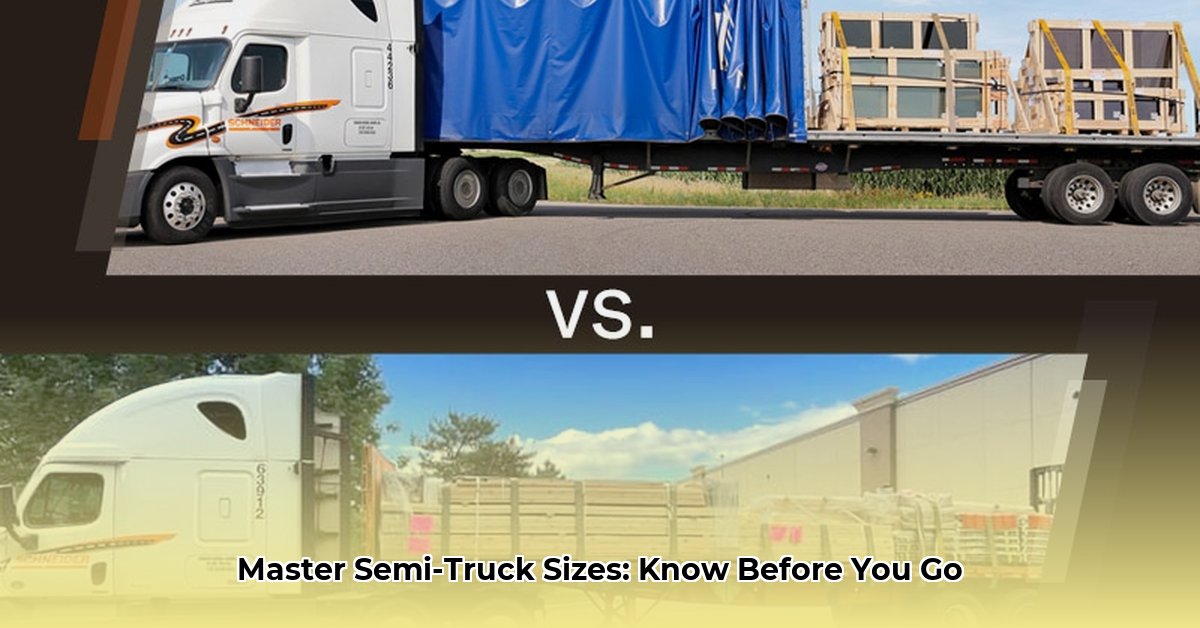
Understanding semi-tractor trailer dimensions and weight limits is critical for legal and efficient trucking operations. This guide provides a comprehensive overview of US regulations, offering actionable steps for compliance and route planning. For more detailed information on trailer sizes, check out this helpful resource on tractor trailer dimensions.
Standard Semi-Tractor Trailer Dimensions
Standard semi-trailers typically measure 53 feet in length, 8.5 feet in width, and 13.5 feet in height. However, these are average dimensions; variations exist depending on trailer type and configuration. The overall length of the combination (tractor and trailer) frequently exceeds 70 feet. Always confirm the exact dimensions of your specific setup.
State-Specific Regulations: A Key Consideration
While federal regulations establish minimum standards, individual states impose unique rules, leading to significant variations. Some states may permit longer combinations, particularly under specific conditions, while others maintain stricter limits. For example, Texas and Oklahoma often allow longer combinations than other states, but always verify current regulations with official state sources.
Example State Variations: (Note: Regulations change frequently; consult official sources for the most up-to-date information.)
| State | Maximum Trailer Length (ft) | Notes |
|---|---|---|
| California | 53 | Often considered a national standard. |
| Texas | Up to 75 (with permits) | Longer combinations may be permitted with special permits and route restrictions. |
| Oklahoma | Up to 75 (with permits) | Similar to Texas; specific regulations may differ. |
| Florida | 53 | Generally adheres to national standard lengths. |
| New York | 53 | Typically follows the national standard. |
Failing to comply with state-specific rules may result in significant fines and operational delays. Diligent research is essential before embarking on any trip.
Specialized Trailers: Dimensions and Permitting
Specialized trailers, such as step-decks, double-drops, and lowboys, possess unique dimensions, often requiring special permits. These trailers are designed for oversized or uniquely shaped cargo, necessitating careful route planning and adherence to specific regulations. Obtaining necessary permits well in advance is crucial to avoid delays and penalties. The permit application process often requires detailed documentation of the load and planned route.
Route Planning: A Step-by-Step Guide to Compliance
Effective route planning is paramount for avoiding violations and ensuring smooth operation. This process requires a meticulous approach:
- Precise Measurement: Carefully measure the cargo's dimensions, accounting for protrusions. Accuracy is critical.
- Regulatory Research: Consult each state's Department of Transportation (DOT) website for precise dimensional and weight limits.
- GPS Utilization: Employ GPS technology to identify potential obstacles like low bridges or weight restrictions along the planned route. However, don't solely rely on GPS; independent verification is recommended.
- Alternative Route Planning: Develop alternative routes to mitigate unforeseen road closures or other issues.
- Comprehensive Documentation: Maintain detailed records of all permits, route adjustments, and other relevant information.
This five-step process minimizes the risk of non-compliance. Neglecting any step increases the probability of costly delays and penalties.
Risk Mitigation: Protecting Your Business
Non-compliance carries severe financial and operational risks. Proactive measures are vital:
- Proactive Permitting: Secure necessary permits well in advance of your trip.
- Thorough Route Assessment: Employ reliable mapping tools that provide comprehensive information, including bridge clearances, weight limits, and other restrictions.
- Driver Training: Ensure your drivers receive thorough training on regulations, route planning, and safe driving practices.
- Regular Vehicle Maintenance: Prevent breakdowns that could lead to delays or accidents.
Conclusion: Ongoing Compliance is Key
The trucking industry is dynamic, with regulations subject to change. Continuous vigilance and proactive planning are essential for maintaining compliance, ensuring safety, and protecting your business. Regularly review state DOT websites and industry publications to stay informed about updates. Remember, understanding and adhering to these regulations is not merely a legal requirement but a critical aspect of safe and efficient operations. The insights shared in this guide aim to provide a comprehensive foundation, empowering you to navigate the complexities of semi-tractor trailer dimensions and US compliance effectively.
"Careful planning and meticulous adherence to regulations are the cornerstones of a successful and compliant trucking operation," says Dr. Anya Sharma, Professor of Transportation Logistics at the University of California, Berkeley. "Ignoring these guidelines can lead to significant financial and operational setbacks."